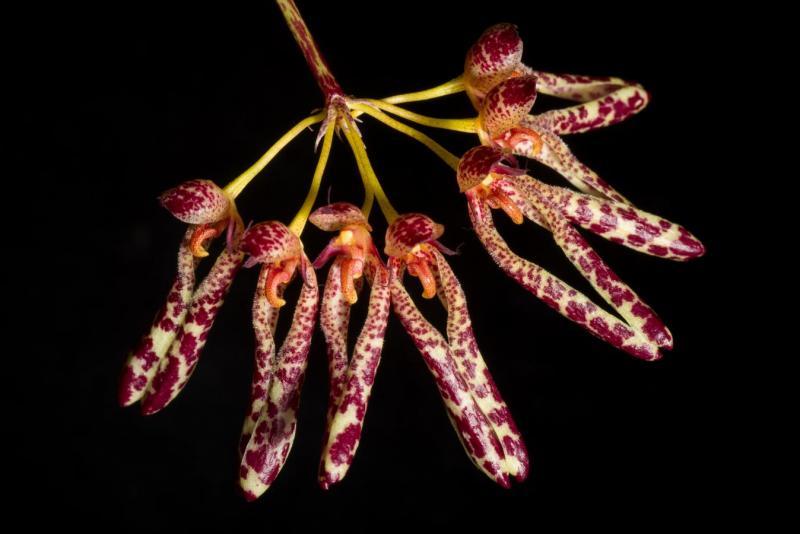Cymbidium elegans
Also known as: The Elegant Cymbidium or Cymbidium elegans var. lutescens Cymbidium densiflorum Cymbidium elegans var. obcordatum Cyperorchis longifolia Cymbidium elegans var. elegans Cymbidium elegans var. lushuiense Cymbidium lushuiense Cymbidium longifolium Limodorum angustifolium in the subfamily: Epidendroideae
Native to: Bhutan China Meghalaya - India Nepal
General Information
The Elegant Cymbidium is a sympodial cool to warm growing epiphytic or lithophytic orchid belonging to the sub family Epidendroideae native to Bhutan, China, India, and Nepal.
Plant Description
Sympodial. Grows to 72cm. Each new growth has numerous elliptic leaves that grow to 1.4-80cm long. Pseudobulbs grow to 4-7cm
Flowers
Numerous fragrant blossoms appear during Autumn
Fragrance
The orchid is fragrant.
Blooming Season
- Autumn
Substrate(s)
- Coarse
- Medium
- Small
- Fine
- Bark
- Charcoal
- Spaghnum Moss
- Perlite
- Sand
Care Notes
This orchid goes into a dormancy phase during winter, during this phase it is best not to provide water unless the plant is starting to look thirsty. The lack of water increases the chance of flowering in spring, and also reduces the likelihood of any rot forming. Do not resume watering until new growth has appeared and is growing strongly.
Often a period of intense growth occurs after dormancy. During this time the amount of light, water and fertiliser the plant receives will directly impact the amount of growth that occurs during this time, and in the case of seedlings, will reduce the time required to reach maturity.
It's recommended to heavily reduce the water amount at the middle to end of autumn to trigger dormancy. Leaves on older bulbs will begin to drop during this time while the newer bulbs continue to mature until terminal leaves appear at the tip of the pseudobulbs.
Repotting can be done any time of the year though it's best to do it in early spring when new growth is appearing as this also means new roots will appear to help the plant anchor into the new media and offset any damage to established roots during the repotting process.
Fragrant:
- IsFragrant
Climate
Grows at high elevations. Rainfall ranges from 5mm to 546mm per day, heaviest in June and lightest in December. Humidity ranges from 51% to 84%, highest in September and lowest in March. Temperature ranges from 3C to 23C, highest in April (17C to 23C) and lowest in January (3C to 14C).
Watering
These orchids are sensitive to excessive watering and should only be watered when they look thirsty. Water infrequently and ensure that the roots are dry before watering. Keep an eye on them especially during hot weather as overwatering can lead to rot, whereas underwatering may result in wilting or shriveling, which while unattractive, will not kill the plant.
Fertiliser
These plants thrive on fertiliser, especially during periods of growth. Liquid fertiliser can be applied at the recommended strength, augmented with manure pellets or other quickly degradable fertiliser, applied away from the base of the plant, during periods of strong growth that occurs in the middle of the growth season.
Do not fertilise during the dormant period. Avoid using slow release fertiliser that breaks down for longer than 3 months, if using apply only after dormancy when new shoots have developed noticably, applied 4-5 pellets per cup (250ml) of media.
They can benefit from a high phosphate fertiliser leading up to flowering season, and by a high nitrogen fertiliser when new growth appears.
Use balanced fertiliser year round. Be sure to flush out excess fertiliser by running water through the media regularly year round. Fertiliser can be applied heavily year round. Use a low Nitrogen fertiliser during Summer and Winter. Use a high Phosphorous fertiliser during Summer and Winter.Potting
It's best to observe the root system when repotting and use that as a guide:
A plant with a short root system will do better in a shallower pot with a fine mix, or mounted on fern or cork supplanted with a good amount of moss or similar material.
A plant with a long root system often does well in a pot filled with moss or fine media, mixing in perlite and charcoal is always beneficial to reduce the likelihood of the mix becoming soggy and keeps it fresh.
A plant with a coarser long root system can be potted in a deeper pot, but with 2/3 coarse material such as bark, expanded clay, or coco chips and topped with moss or similar material. This will allow the moisture to remain inside the pot but give the roots air as well.
This plant does very well in baskets or suspended pots This plant does well mounted. Repotting is best done annually.





















